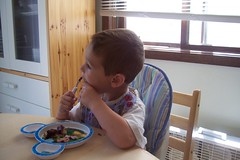And I promised myself that I would do this challenge, so that even when life is hectic, I will carve out some time to be in my kitchen. I do have to laugh when I think of Peter Reinhart's advice (I chuckled when I first read it, too): "Arrange to have as few distractions as possible....Minimize conversation....Success in bread making, as in any facet of life, comes down to one word: focus" (p. 51, The Bread Baker's Apprentice). My first guess is that Peter Reinhart would shudder if he saw the conditions in which I bake: kid drumming on mixing bowls, kid clinging to my legs, kids yelling at each other and fighting over wooden spoons, dinner on the stove and needing attention, supplies still in cupboards or drawers. My second guess is that if I had to wait for his ideal conditions, I wouldn't start baking until years from now, especially since his recipes are complicated and require more than just the hour or two I have free during nap time.
Anyway, this is a long-winded way of saying that I made bread #6 today (challah), but didn't get any pictures taken of the process. Helpfully I've made challah before (this past summer), although not with this recipe; I used the one posted by Deb at Smitten Kitchen. This is my first challah:
We'll see how they compare.
This bread is the first to start without a starter: you just jump right into stirring the dry ingredients, whisking the wet, and combining them. He gives the option of stand mixer or hand, and (given the insanity of my house this morning) I chose the former. I mixed it for 6 minutes and only added a tiny bit of extra water, unlike the other posters I read who had to add a bunch. After 6 minutes, it was still really sticky, so I added more flour...and then more...and mixed it for another 3 or 4 minutes. Finally I got nervous, so I pulled it out of the bowl, decided to let it sit for a little while, and then continued kneading by hand. I still had to add so much flour, and although I could get the dough to register 78 degrees and it was nice and smooth, I could not get it up to 80 degrees or get the windowpane test to work. Finally after an additional 15 or 20 minutes working on it, I had to give up and take care of the kidlets. Like I said, the dough looked and felt beautiful, even if it didn't pass the tests.

It rose for an hour, and then I kneaded it for 2 minutes to degas it. It still felt lovely, satiny smooth. Then it's supposed to rise for another hour and get to 1 1/2 times its original size. Given when the hubbie had to leave for football, I only let it rise for about 48 minutes, although it had definitely grown to the appropriate size.
I decided to try the 4-strand braid because it looked more interesting than the 3 and I had already done the 6-strand with my last challah. As with the pretzels, I had trouble with my technique rolling out the dough into strands. I found this video how-to which gave me a few pointers (and allowed the dough to rest a bit while I was browsing for tips). Also, instead of fighting with the individual strands, I would roll one, then allow it to rest while I started on the second, then go back to the first and get it to lengthen a bit more, then start the third, then go back to the second, and so on, until I finally got all 4 strands to be equal length and thickness, with the thickest part in the middle.
I liked the 4-strand braid technique; it was easy and looked pretty. I also paid close attention to my braiding, as Jon T commented on Nicole's (Pinch My Salt) post that you need to give the dough enough room to expand during proofing and again in the oven. If you braid too tightly, the dough and bread will tear down the middle. I remember that the last time I made challah, mine did just that, so I did my best to keep it loose.
Results
Looks: Well, I think I did a pretty good job braiding. It's not the most beautiful braid, but it didn't tear much, so I accomplished that. Has a deep golden color and it rose well.
Texture: Lighter than I'm used to with challah, but nice.
Taste: Very disappointing. It's like a good quality white sandwich bread, I guess (I'm not a big fan of white sandwich bread). It's lacking that rich, slightly sweet taste of challah, which I guess isn't too surprising since it has less sugar and fewer eggs than the other recipe.
I don't think I'll make this one again. If I want a yummy traditional challah, I'll stick to the Joan Nathan recipe posted and adapted by Deb. Not that I'm sad that I baked this one; I'm sure it will provide us with a couple of meals of delightful French toast this week!


















































